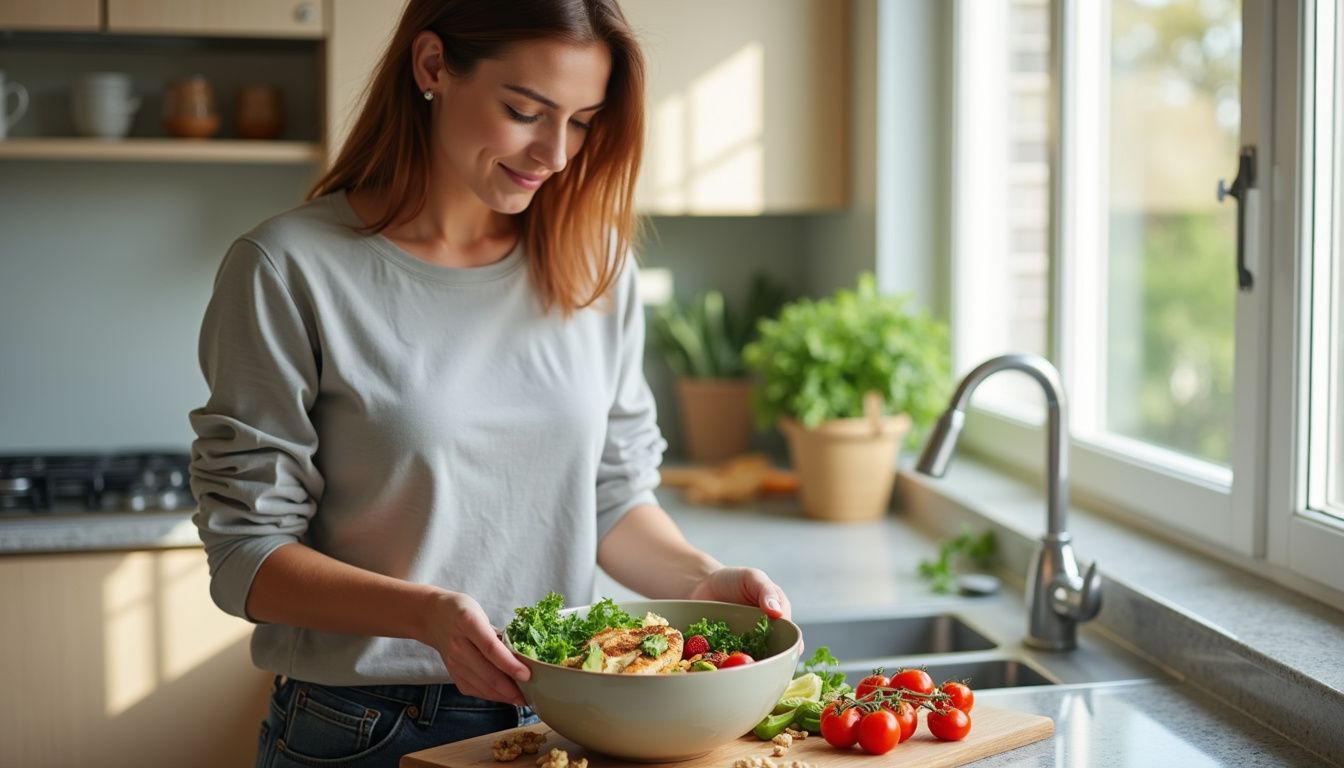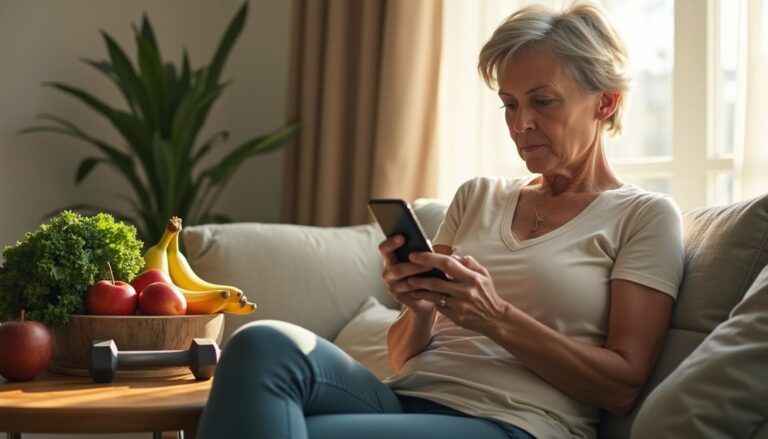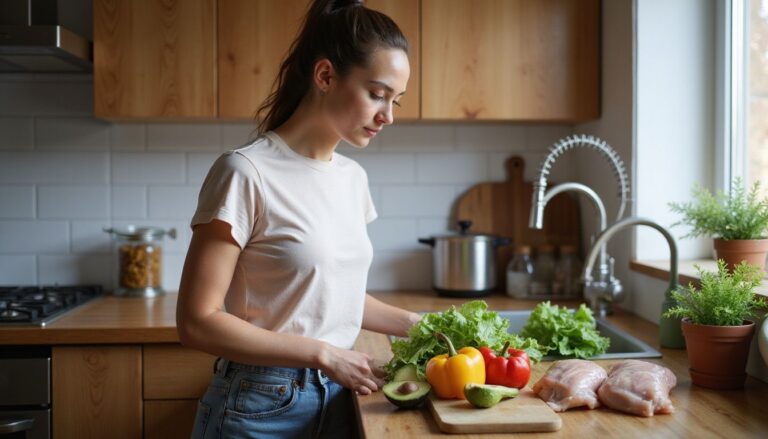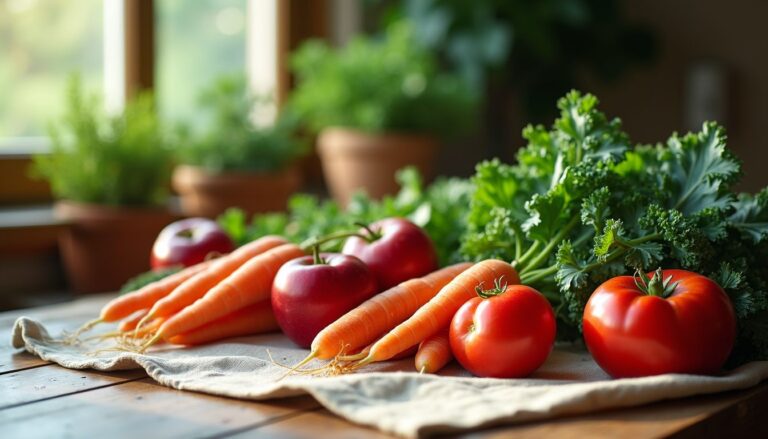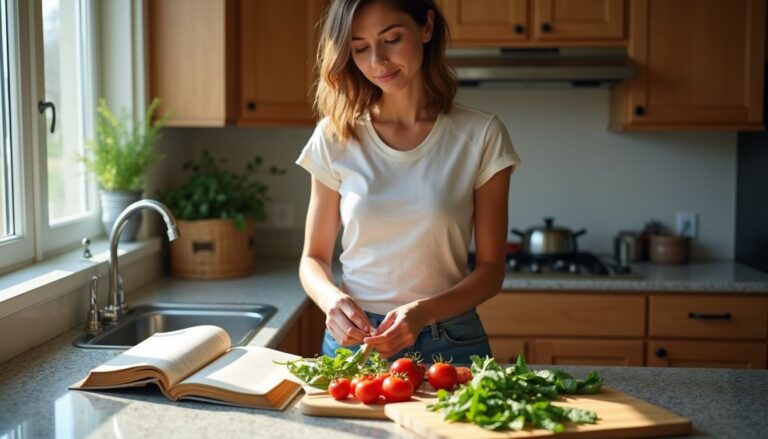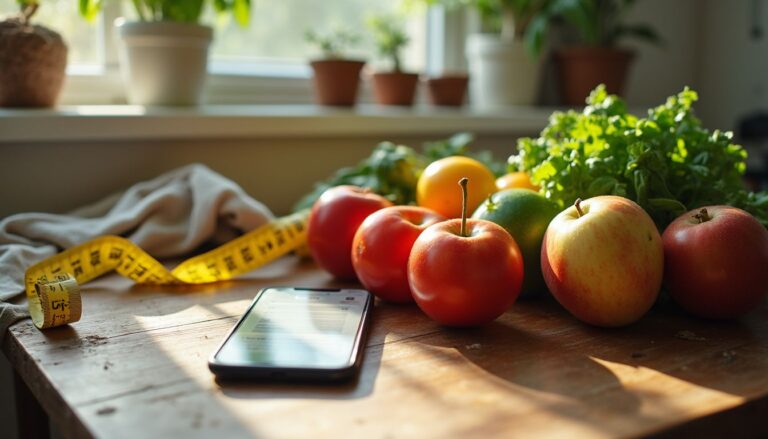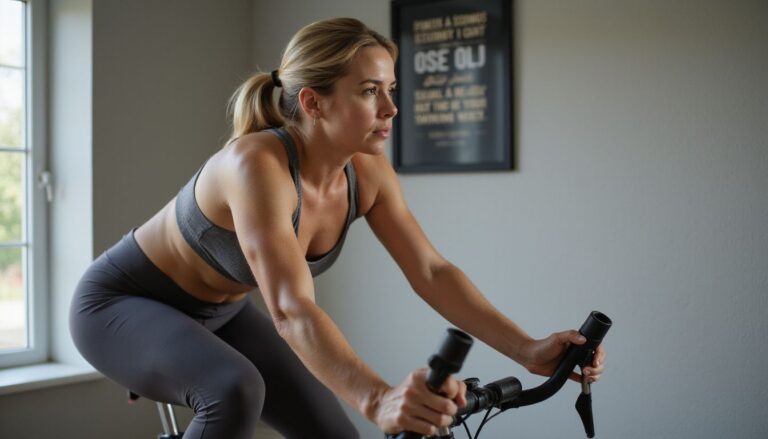Delicious Lunches For Weight Loss: Healthy Lunch Ideas To Help You Shed Pounds
Our Nutrition Assistant AI Suite will transform your body. You will lose fat, get toned, and build muscle. Gain confidence and optimal health.
You might feel stuck making lunch each day, especially if you want options that help with weight management. A balanced lunch with protein, fiber, and healthy fats controls hunger and supports steady energy. These lunch ideas for weight loss show you how to build fast, tasty meals without giving up flavor.
This guide shares healthy lunch ideas, simple lunch recipes, meal prep tips, and practical nutrition facts. You will find proven strategies to hit your goals, plus expert-backed advice you can use right away. Look here for your next midday meal that works hard for you.
Key Takeaways
- High protein at lunch is linked to less evening snacking, according to the American Journal of Clinical Nutrition, 2014.
- Aiming for 25–40 grams of protein and 8–12 grams of fiber at lunch helps preserve muscle, improves fullness, and supports steady blood sugar.
- Meal prepping lean proteins, whole grains, healthy fats like olive oil or avocado, and fiber-rich vegetables supports portion control all week.
- Balanced midday meals, as recommended by the National Institutes of Health, support healthy calorie restriction and reduce afternoon cravings.
- Replacing processed foods with whole ingredients like quinoa, beans, salmon, chickpeas, or tofu lowers sodium and improves diet quality.
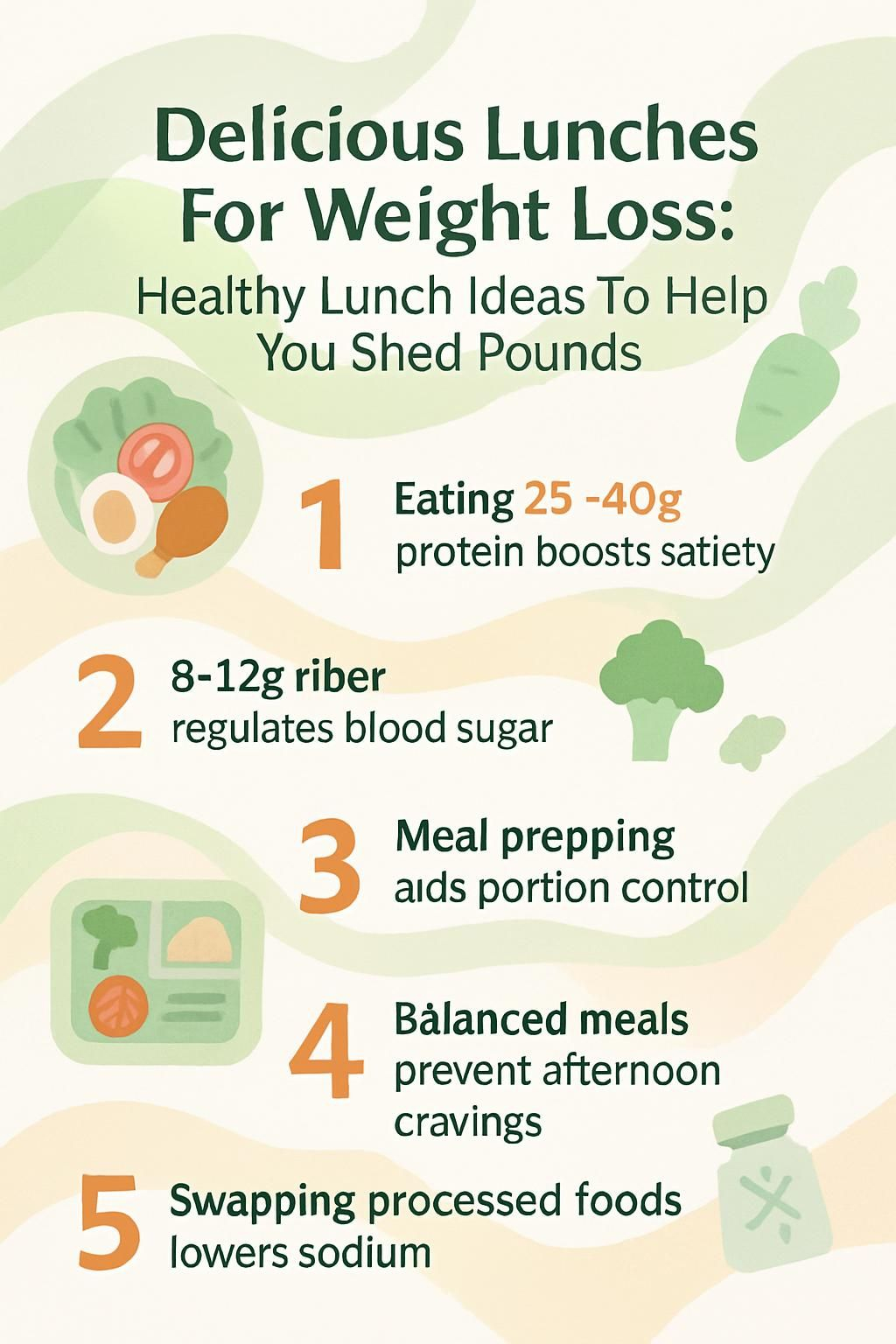
How to Build Healthy Lunches for Weight Loss
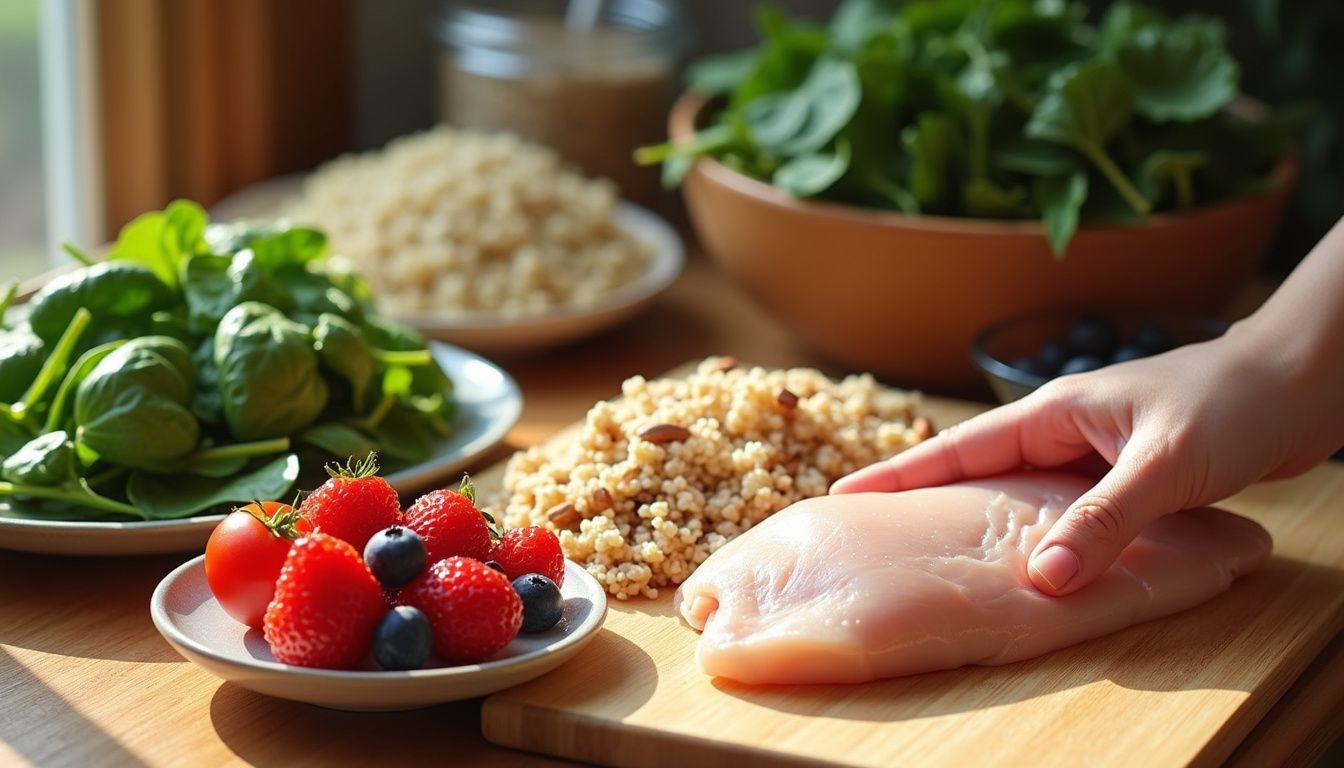
Build each lunch like a simple checklist, protein, produce, smart carbs, and healthy fats. This structure keeps you full, helps portion control, and fuels your afternoon.
Why should I focus on lean proteins for lunch?
Lean proteins such as chicken, tuna, salmon, tofu, beans, Greek yogurt, and eggs help you feel full longer. Target 25 to 40 grams of protein at lunch to support muscle and raise the calories your body burns while digesting food. High protein meals, like a grilled chicken salad with avocado or tuna lettuce wraps, reduce cravings later in the day.
Protein helps preserve muscle and burns more calories during digestion, making it a smart choice for lunch to support weight loss, says a registered dietitian.
After switching to high protein lunches, I noticed fewer afternoon slumps and fewer snack urges. Packing a protein-rich wrap or chickpea salad sandwich kept me satisfied until dinner and improved focus at work.
Including lean protein at midday sets up healthy habits and helps you control your appetite.
What are the best fiber-rich vegetables to include?
Broccoli, zucchini, sweet potatoes, peppers, carrots, and mixed greens offer fiber that supports fullness. Aim for at least 2 cups of non-starchy vegetables at lunch. Target 8 to 12 grams of fiber per meal to slow digestion and steady blood sugar. Lentils, black beans, and avocado add extra fiber and make low-calorie lunches more satisfying.
I roast a sheet pan of Brussels sprouts with olive oil during weekend prep. It makes grain bowls and wraps hearty without adding many calories. Mixing spinach or shredded carrots into hummus wraps is another simple way to raise fiber without losing flavor.
Which whole grains or complex carbs support weight loss?
Choose quinoa, brown rice, or whole grain bread for slow energy and better blood sugar control. These smart carbs provide fiber and help you feel satisfied after lunch. Sweet potatoes, chickpea pasta, and lentil pasta are good options too.
Use a fist-sized serving of these carbohydrates to support portion control. Swap white bread for whole grain, or add beans to soup for extra fiber. I often cook a batch of quinoa or brown rice on Sunday, then add it to salads, wraps, or leftover chicken to build balanced lunches.
How can I limit processed foods in my lunch?
Processed foods often pack extra sodium, sugar, and unhealthy fats. These can leave you hungry and slow your progress. Replace white bread with whole grain wraps, and use roasted vegetables instead of fried sides. Skip deli meats like ham and bacon due to preservatives and high salt, which may cause bloating.
Build meals with simple ingredients. Use grilled chicken, chickpeas, or beans for protein. Make salads with cucumber, tomatoes, greens, and a light vinaigrette instead of heavy dressings. Bake sweet potatoes instead of buying packaged snacks. Choose water over sugary drinks to control calories and appetite.
What healthy fats help keep me full longer?
Olive oil, avocado, nuts, and seeds add healthy fats that regulate hunger hormones and slow digestion. A thumb-sized portion per meal works well for most people. Chia seeds offer omega-3 fats, and walnuts provide polyunsaturated fats, both support fullness for hours.
Drizzle olive oil on salads or tuck sliced avocado into a chicken wrap for creaminess. Add almonds or sunflower seeds to Mason jar salads. Including protein and healthy fat kept me satisfied long after lunch, so I avoided afternoon cravings and stayed on track.
What Are the Benefits of Eating Healthy Lunches for Weight Loss?
Healthy lunch ideas for weight loss support your goals while keeping you satisfied. A balanced midday meal fuels you without a crash.
How do healthy lunches keep me full and energized?
Combining protein, fiber, healthy fats, and complex carbs creates lasting fullness and steady energy. Meals with 25 to 40 grams of protein, like grilled chicken or lentil soup, help preserve muscle and keep hunger away. Fiber from chickpeas or roasted sweet potatoes slows digestion, which supports focus through the afternoon. Healthy fats such as avocado and olive oil add flavor and help manage appetite hormones. Complex carbs like brown rice provide slow-burning fuel.
Hydrating foods such as cucumbers and melons can reduce bloating and help concentration. A Mason jar salad with leafy greens, turkey, and quinoa kept me satisfied for hours and made my afternoon more productive.
Use these building blocks to control portions and support your plan. Balanced choices at lunch make it easier to stay consistent the rest of the day.
How can healthy lunches help with portion control?
Weighing ingredients with a food scale gives accurate portions. Pre-portioning meals in labeled containers makes calorie goals easier to meet. Many people batch cook chicken, whole grains, and vegetables to reduce stress and simplify weekdays.
Color-coded stickers can organize meals by day. Eating a well-portioned lunch makes snacking less tempting. Using pre-portioned containers helped me hit 400 calories or less per lunch without feeling hungry. Simple systems turn recipes into easy wins.
Why do healthy lunches prevent overeating later?
Planned lunches with protein and fiber reduce evening hunger. A meal that combines chicken breast, chickpeas, and quinoa can hold you for hours. Skipping lunch often leads to an energy dip, then cravings for low-quality snacks.
Research shows that people who eat a balanced lunch take in fewer calories at dinner than those who skip it. A salad with eggs or tofu kept me from feeling ravenous by dinnertime, which made it easier to make wise choices.
- A 2014 American Journal of Clinical Nutrition study found higher protein lunches were linked to less evening snacking.
- The National Institutes of Health encourages balanced midday meals for steady energy and healthy calorie control.
If strong urges continue, talk with a registered dietitian or healthcare professional for personalized help.
How do balanced lunches maintain steady energy levels?
Balanced lunches combine complex carbs, protein, and healthy fats for a smooth energy curve. Whole grains like quinoa support steady blood sugar. Lean proteins and fats from grilled chicken or avocado slow digestion, so energy lasts longer. Avoid sugary drinks and refined carbs to prevent spikes and crashes.
Drink water to support metabolism and reduce bloating. Fiber-rich vegetables and plant proteins like chickpeas also help you stay alert. Balanced plates make it easier to resist cravings and support your eating plan for the rest of the day.
Quick and Easy Lunch Recipes for Weight Loss
Explore fast, satisfying lunch recipes using whole grains, lean protein, and vegetables. These cold lunches and hot meals come together in minutes, which makes eating well simpler.
How to make Mason Jar Salads with Chickpeas and Veggies?
Mason jar salads are portable, fresh, and easy to prep. Chickpeas, crunchy vegetables, and healthy fats make a filling, flavorful lunch.
- Start with rinsed chickpeas for plant protein. A half cup gives about 7 grams of protein and 6 grams of fiber.
- Layer cucumbers, cherry tomatoes, carrots, and red onion for crunch and volume with few calories.
- Add cooked quinoa or brown rice for steady energy. Use about 1/4 cup per jar.
- Pour in 1 tablespoon olive oil mixed with lemon juice for a bright, healthy dressing.
- Season with fresh basil or chili flakes for bold flavor without extra sodium.
- Boost protein with Greek yogurt on the side or a sliced boiled egg. This can lift each jar toward 25–40 grams of protein and 8–12 grams of fiber.
- Seal tightly and refrigerate for up to four days for quick work lunches.
- Prepping these jars each week cut my fast food runs and kept my energy steady.
This method fits busy schedules and supports steady blood sugar through the afternoon.
What is a simple recipe for Greek Yogurt Chicken Salad Wraps?
Greek Yogurt Chicken Salad Wraps are creamy, high in protein, and light on calories. Use whole grain tortillas or crisp lettuce leaves to fit your plan.
- Use cooked, shredded chicken breast, about 4 ounces per serving.
- Mix chicken with nonfat Greek yogurt instead of mayo to raise protein and lower calories.
- Add diced celery and grapes for crunch, fiber, and a hint of sweetness, plus chopped parsley.
- Season with black pepper and a small pinch of salt. Stir until coated.
- Spoon the mixture into whole grain tortillas or large lettuce leaves.
- Each wrap can reach 25–40 grams of protein while staying under 600 calories.
- Add a teaspoon of mustard or lemon juice for extra tang before rolling.
- Serve with carrot sticks or a few roasted nuts for more fiber and healthy fats.
- Refrigerate leftover filling for up to two days for easy planning.
- This recipe takes about 20 minutes with basic tools, a bowl and spoon.
- It offers a lighter swap for mayo-heavy deli salads while keeping flavor high.
How do I prepare Zucchini Noodles with Turkey Bolognese?
Zucchini noodles with turkey Bolognese provide fiber and protein with fewer calories than pasta. Keep noodles and sauce separate for the best texture.
- Spiralize 2 to 3 medium zucchini for a low carb, high fiber base.
- Heat 1 tablespoon olive oil in a skillet. Sauté 1 diced onion and 2 minced garlic cloves for 3 minutes.
- Add 1 pound lean ground turkey. Cook 6 to 8 minutes, breaking it up as it browns.
- Stir in 1 cup chopped tomatoes, 1 teaspoon Italian herbs, 1/2 teaspoon salt, and pepper. Cook 8 to 10 minutes.
- Add 1/2 cup tomato sauce for moisture and depth.
- Simmer briefly, then finish with a small drizzle of olive oil for satiety.
- Store sauce and raw zoodles separately for meal prep.
- Warm noodles for 30 seconds, then top with sauce to keep them crisp-tender.
- You get fewer calories and more vegetable fiber than with classic pasta.
- Swap turkey for sautéed soybean crumbles for a plant based version.
How to make Avocado and Tuna Lettuce Wraps?
Avocado and Tuna Lettuce Wraps are fast, balanced, and portable. They deliver protein, fiber, and healthy fats for a steady afternoon.
- Drain one can of tuna packed in water to keep calories lower.
- Cube one ripe avocado and mix with tuna for healthy fats and creaminess.
- Add lemon juice and chopped celery for brightness and crunch.
- Season with a pinch of salt and pepper, then mix gently.
- Spoon filling into large, sturdy lettuce leaves for a low carb taco style wrap.
- Each wrap balances protein, fiber, and healthy fats to keep you satisfied.
- Serve with coleslaw or pineapple slices for extra vitamins and texture.
Try these and other high protein lunch ideas to support your goals.
What are the steps for Stuffed Sweet Potatoes with Hummus Dressing?
Stuffed sweet potatoes with hummus dressing offer fiber, plant protein, and healthy fats. They are great hot at home or as a meal prep lunch.
- Preheat the oven to 400°F to bake the sweet potatoes until tender and caramelized.
- Wash and dry 2–4 medium sweet potatoes. Pierce with a fork to vent steam.
- Roast on a parchment lined baking sheet for 45–55 minutes, until soft.
- Roast broccoli and red peppers at 400°F for about 20 minutes for color and fiber.
- Rinse black beans or chickpeas for plant protein.
- Split each potato and scoop a little flesh out to make room for fillings.
- Fill with beans and roasted vegetables for a hearty lunch.
- Whisk hummus with lemon juice and a splash of water for a creamy dressing, then drizzle.
- Each potato can reach about 8–12 grams of fiber and 25–40 grams of protein, based on portion size.
- Serve warm or refrigerate for easy meals during the week.
High-Protein Lunch Ideas to Support Weight Loss
High protein lunches such as fish, chicken curry, or peanut butter based meals help you stay full and focused. Use the ideas below to build meals you will look forward to.
How to prepare Grilled Chicken and Quinoa Bowls?
Grilled Chicken and Quinoa Bowls combine lean protein, whole grains, and vegetables for steady energy with fewer calories.
- Grill chicken breast or thighs over medium-high heat for 5 to 7 minutes per side, to 165°F.
- Cook quinoa with 2 cups water per 1 cup quinoa. Simmer about 15 minutes until fluffy.
- Roast broccoli and bell peppers at 425°F for 15 to 20 minutes with olive oil and a pinch of salt.
- Layer quinoa, then sliced chicken, broccoli, and peppers.
- Finish with 1 tablespoon olive oil and lemon juice per bowl for flavor and fullness.
- Sprinkle roasted nuts for crunch and nutrients.
- Batch cook chicken and quinoa to speed up weekday lunches.
Prepped bowls make it easier to stick to your plan when days get busy.
What is a healthy Cottage Cheese and Cucumber Toast recipe?
Cottage Cheese and Cucumber Toast is light yet satisfying. It packs protein, fiber, and healthy fats with only a few ingredients.
- Toast one slice of whole grain bread for complex carbs and extra fiber.
- Spread about 1/2 cup low fat cottage cheese for at least 14 grams of protein.
- Top with thin cucumber slices for crunch and hydration.
- Sprinkle fresh dill for flavor without extra salt.
- Drizzle a teaspoon of olive oil to add healthy fat and satiety.
- Add black pepper or chili flakes to taste.
- Serve with mixed greens or fruit to round out the meal.
I often make this during busy weeks because it is quick and keeps me full until mid afternoon.
How do I make Lentil and Spinach Soup for lunch?
Lentil and spinach soup is simple, filling, and great for meal prep. You get protein and fiber in every bowl.
- Rinse 1 cup dry lentils. Add to a pot with 4 cups low sodium vegetable broth.
- Stir in 1 cup each of spinach, diced carrots, and tomatoes for extra nutrients.
- Season with 2 teaspoons of cumin, smoked paprika, and garlic powder for flavor without more calories.
- Simmer about 30 minutes until lentils are tender, stirring occasionally.
- Each serving can deliver 8 to 12 grams of fiber and meaningful protein, supporting fullness and gut health.
- Divide into containers for easy lunches throughout the week.
- Roast carrots first for sweetness, and sauté garlic for more depth.
How to create Salmon Salad with Dijon-Caper Vinaigrette?
Salmon Salad with Dijon-Caper Vinaigrette offers protein, omega-3 fats, and crisp vegetables. It tastes rich without heavy ingredients.
- Use baked or canned salmon as the protein. A 3 ounce serving has about 21 grams of protein and omega-3 fats.
- Toss salmon with mixed greens such as spinach, arugula, or romaine.
- Add sliced tomatoes and cucumber for crunch and vitamin C.
- Include cooked quinoa for extra fiber and steady energy.
- Whisk 1 tablespoon Dijon mustard, 1 tablespoon capers, 2 tablespoons olive oil, and 1 tablespoon vinegar.
- Toss salad with the vinaigrette. The mustard and capers add bright flavor.
- Pre-portion into containers for grab-and-go lunches. Keep up to three days refrigerated.
- Healthy fats from salmon and olive oil plus fiber from greens make this lunch filling.
- Serve chilled or at room temperature for a fast, no-cook meal.
- It fits well in a weekly rotation of healthy lunch ideas.
Vegetarian and Vegan Lunch Options for Weight Loss
Plant based lunches can lower calories while boosting fiber and nutrients. The options below are colorful, filling, and easy to pack.
What is included in a Rainbow Buddha Bowl with Tofu?
A Rainbow Buddha Bowl with Tofu delivers protein, fiber, and healthy fats in one colorful bowl.
- Use 25 to 40 grams of baked tofu for a reliable protein base.
- Add carrots, peppers, broccoli, and red cabbage for fiber, vitamin A, vitamin C, and antioxidants.
- Include brown rice or quinoa for long lasting energy.
- Drizzle tahini or an olive oil dressing for healthy fats that support fullness.
- Top with sesame seeds for crunch and minerals.
- Pack ahead. The bowl keeps well for up to three days.
- These bowls are quick to prep and very satisfying during busy weeks.
- Plant based meals like this can reduce calories while increasing fiber, according to Harvard T.H. Chan School of Public Health, 2022.
- Add a side of cauliflower soup if you want more volume with few calories.
How to make a Vegan Chickpea Salad Sandwich?
This vegan chickpea salad sandwich is hearty and protein-rich. It can reach 12 grams of fiber and up to 40 grams of protein depending on portion size.
- Rinse a can of chickpeas. Mash with a fork until chunky.
- Stir in diced celery, carrots, and red onion for fiber and crunch.
- Add 1 tablespoon olive oil, lemon juice, and a spoon of mustard for a tangy dressing.
- Mix until evenly coated for a consistent texture.
- Serve on whole grain bread for more fiber, or use lettuce leaves for fewer calories.
- Season with black pepper or paprika for extra flavor.
- Each sandwich can target 8–12 grams of fiber and 25–40 grams of protein.
- This lunch kept me full through long meetings and reduced cravings until dinner.
How do I prepare Spaghetti Squash with Sautéed Chickpeas?
Spaghetti squash with sautéed chickpeas offers a low-calorie base with a protein topping. It helps you feel full without heavy pasta.
- Preheat the oven to 400°F.
- Halve the squash lengthwise and remove seeds. Place cut side down on a baking sheet.
- Roast 35 to 40 minutes until tender. Scrape strands with a fork once cool.
- Heat 1 tablespoon olive oil in a skillet over medium heat.
- Add one 15 ounce can of drained chickpeas with two minced garlic cloves. Sauté 5 to 7 minutes until lightly browned.
- Stir in 1 cup spinach and 1 cup halved cherry tomatoes. Cook until spinach wilts.
- Season with salt, pepper, and dried herbs like oregano or basil.
- Drizzle a little olive oil, then spoon over the squash strands to serve.
- Store squash and topping separately for easy meal prep.
These plant based lunches are flavorful, budget friendly, and easy to customize with seasonal produce.
What is a good recipe for Roasted Veggie and Quinoa Salad?
Roasted veggie and quinoa salad is fresh, filling, and ideal for make-ahead lunches. It uses staple pantry items and flexible vegetables.
- Preheat the oven to 400°F. Chop broccoli, zucchini, and peppers into even pieces.
- Toss vegetables with 1 tablespoon olive oil and a pinch of salt. Spread in a single layer.
- Roast for about 20 minutes, stirring once halfway through.
- Cook 1 cup quinoa as directed. Fluff with a fork.
- Rinse 1 cup chickpeas or black beans. Add to the quinoa for extra protein and fiber.
- Combine roasted vegetables with quinoa and beans in a large bowl.
- Dice half an avocado or add 2 tablespoons of pumpkin or sunflower seeds for healthy fats.
- Squeeze lemon juice and drizzle 1 tablespoon olive oil. Toss to coat.
- Portion into containers for the week.
- Refrigerate up to four days. Serve cold or at room temperature.
This salad supports weight loss goals, limits processed foods, and works with many vegetables.
Low-Carb Lunch Choices for Weight Loss
Low carb lunches help with blood sugar control and appetite. These choices limit added sugars and still keep you satisfied.
How to make Cauliflower Rice Stir-Fry with Shrimp?
This cauliflower rice stir fry delivers lean protein, fiber, and bold flavor with fewer carbs.
- Gather ingredients, 1 pound shrimp, 3 cups cauliflower rice, 1 cup peas, 1/2 cup diced carrots, 1/2 cup sliced scallions, and 2 tablespoons low sodium soy sauce or tamari.
- Thaw shrimp if needed. Peel and devein, then pat dry.
- Heat 1 tablespoon olive oil in a skillet over medium-high. Cook shrimp 2 to 3 minutes until pink, then remove.
- Add 1 tablespoon olive oil. Stir fry peas, carrots, and scallions for 3 minutes.
- Add cauliflower rice. Cook 4 to 5 minutes until hot and fluffy.
- Return shrimp. Stir in soy sauce or tamari until coated.
- Serve hot. Each serving is high in protein with fewer than 20 grams of carbs.
What are Keto Egg Salad Lettuce Wraps?
Keto Egg Salad Lettuce Wraps are low in carbs and high in protein. They help you stay full for hours.
- Mix chopped hard boiled eggs with Greek yogurt or mashed avocado for protein and healthy fats.
- Add diced celery and fresh herbs for crunch and flavor.
- Spoon into large romaine or butter lettuce leaves instead of bread.
- Each wrap keeps carbs low and supports steady blood sugar after lunch.
- Skip bread completely if you want to keep net carbs minimal.
- Meal prep the egg mixture ahead of time for busy days.
- Serve with sliced peppers or cucumbers for more fiber.
- The combination of eggs, yogurt or avocado, and veggies keeps you satisfied.
- Flavors stay fresh for hours, which makes these wraps great for work or school.
- Many people find swapping lettuce for bread lowers total calories and helps with weight loss.
How do I prepare Zoodles with Garlic Shrimp?
Spiralized zucchini, called zoodles, makes a light base for protein packed shrimp. It is fast, colorful, and low in carbs.
- Spiralize two medium zucchini for about four cups of noodles.
- Heat 1 tablespoon olive oil in a large pan over medium heat.
- Sauté two minced garlic cloves for about 30 seconds until fragrant.
- Add 8 ounces raw shrimp, season with pepper and a pinch of salt, and cook 2 minutes per side until pink.
- Toss in 1 cup halved cherry tomatoes and 1 cup spinach. Cook until tomatoes soften and spinach wilts.
- Add zoodles to the pan. Toss 1 to 2 minutes until crisp tender.
- Serve right away, or store components separately for meal prep and reheat before eating.
Prepping the noodles and shrimp ahead saved me time and kept everything crisp at lunch the next day.
What is an easy recipe for Grilled Chicken with Steamed Broccoli?
Grilled Chicken with Steamed Broccoli is simple, lean, and satisfying. It fits most low carb plans and reheats well.
- Gather ingredients, one skinless chicken breast, one cup broccoli florets, one tablespoon olive oil, half a lemon, salt, and pepper.
- Preheat grill to 375–400°F.
- Pat chicken dry. Brush with olive oil.
- Season with a pinch of salt and pepper. Add lemon juice if you like.
- Grill 5 to 7 minutes per side, until the internal temperature reaches 165°F.
- Steam broccoli 5 to 6 minutes until bright green and tender.
- Rest chicken for two minutes, then slice for easier portions.
- Serve chicken over broccoli. Finish with lemon juice or a teaspoon of olive oil.
- Each serving has about 35 grams of protein and roughly 7 grams of carbs.
- Store in the fridge up to three days for fast lunches during the week.
This meal supports steady energy without processed sides or extra calories.
Meal Prep Lunch Ideas for Busy Schedules
Meal prep turns good intentions into ready-to-eat lunches. A few steps on one day create less stress the rest of the week.
How to make Pre-Portioned Chicken and Veggie Bowls?
Pre-portioned bowls help you stick to your plan and save time. They offer balanced meals with clear portions.
- Roast boneless, skinless chicken with olive oil, pepper, and garlic powder at 400°F for 20 to 25 minutes.
- Slice chicken into strips or cubes. Aim for 4 ounces per portion, about 30 grams of protein.
- Roast or steam vegetables like broccoli, zucchini, sweet potatoes, and peppers. Roast at 400°F for about 20 minutes.
- Cook quinoa or brown rice for a smart carb base. A half cup cooked quinoa has 4 grams of protein and 2.6 grams of fiber.
- Portion bowls, half vegetables, one quarter chicken, one quarter grains.
- Label containers with calories and macros to track intake.
- Store greens in separate bags to keep them crisp.
- Add healthy fats like a tablespoon of avocado or a drizzle of olive oil just before eating.
- Refrigerate up to four days for grab-and-go lunches.
- Pre-portioned bowls made my choices easier, cut cravings, and helped me make steady progress.
What are Turkey-Cranberry Wraps?
Turkey-cranberry wraps bring a sweet and savory flavor mix. They are easy to prep and travel well.
- Layer lean turkey slices for high quality protein with low saturated fat.
- Add spinach or arugula for fiber, vitamins, and minerals.
- Use a small spoon of dried cranberries for a touch of sweetness.
- Choose whole grain tortillas for complex carbs and extra fiber.
- Spread a thin layer of hummus or low fat cheese for flavor and healthy fats.
- Roll tight and slice in half for simple portions.
- Make several and refrigerate in airtight containers for the week.
How to prepare Overnight Oats with Fresh Berries?
Overnight oats work for lunch too. They are high in protein and fiber, which helps you feel full longer.
- Add 1/2 cup rolled oats to a jar.
- Pour in 1/2 cup low fat milk or unsweetened plant milk.
- Mix in 1/2 cup Greek yogurt to raise protein toward the 25–40 gram target.
- Top with 1/2 cup berries for vitamins and natural sweetness.
- Stir in 1 teaspoon chia seeds or ground flax for omega-3 fats and extra fiber.
- Seal and refrigerate at least six hours or overnight.
- Portion into jars for grab-and-go meals during the week.
Each serving gives complex carbs, protein, and fiber, a combo that supports steady energy and weight loss.
What is a Chopped Salad with Spicy Peanut Dressing?
This chopped salad delivers fiber, healthy fats, and plant protein. It stays crisp if you store the dressing separately.
- Chop cabbage, bell peppers, and carrots for crunch and fiber.
- Add shelled edamame or tofu for plant-based protein.
- Whisk 2 tablespoons peanut butter, 1 tablespoon soy sauce, lime juice, and chili flakes for a spicy dressing.
- Store vegetables and protein apart from the dressing. Toss just before eating.
- Prep several servings to save time during the week.
- One serving provides roughly 10 to 15 grams of plant protein and at least 6 grams of fiber.
- This salad fits vegetarian meal prep and weight loss plans.
Warm or cold, prepped lunches give you control and keep hunger in check.
Warm Lunch Recipes That Support Weight Loss
Warm lunches can feel extra satisfying on busy days. These recipes deliver comfort with smart nutrition.
How to make Smoky Chicken Quinoa Soup?
Smoky Chicken Quinoa Soup is a balanced bowl with protein, fiber, and complex carbs. It freezes well for future lunches.
- Cut boneless, skinless chicken into bite sized pieces for quick cooking.
- Sauté diced carrots, celery, onion, and garlic in a large pot.
- Stir in 1 cup rinsed quinoa for steady energy.
- Add one can diced tomatoes for vitamin C and antioxidants.
- Season with 1 teaspoon smoked paprika, 1 teaspoon cumin, salt, and pepper.
- Pour in 6 cups low sodium chicken broth and bring to a simmer.
- Add chicken so it cooks gently with the grains.
- Stir in 1 cup beans or lentils for 8–12 grams of extra fiber per serving based on portion size.
- Simmer about 20 minutes until chicken is cooked and quinoa is tender.
- Portion into containers for easy warm lunches all week.
What is Curried Carrot-Tomato Soup?
Curried Carrot-Tomato Soup offers bold flavor and a veggie-rich base. It is simple to make and easy to reheat.
- Blend cooked carrots and tomatoes for a fiber and vitamin packed base with beta carotene and vitamin C.
- Add lentils for plant protein and extra fullness. This can add 8–12 grams of fiber per serving.
- Season with curry powder, ginger, and garlic for warmth and antioxidants.
- Make a batch ahead for quick weekday lunches. Store up to four days.
- Serve with whole grain toast for balanced energy.
- Enjoy a satisfying bowl without heavy cream or processed ingredients.
- This meal suits vegetarian plans and low-calorie lunch routines.
How do I prepare Healthy Chicken Fajita Wraps?
Healthy Chicken Fajita Wraps offer lean protein, fiber, and smart carbs. Prep the filling once, then assemble wraps in minutes.
- Slice 4 ounces of skinless chicken breast for each wrap.
- Sauté chicken with 1 cup each of bell peppers and onions for 6 to 8 minutes.
- Season with cumin and smoked paprika. Add a squeeze of fresh lime juice.
- Fill a whole grain tortilla with the chicken and vegetables.
- Cook extra filling and store for fast lunches all week.
- Each wrap can provide about 25–40 grams of protein and under 600 calories.
- Tip, add leafy greens or salsa for more texture and flavor.
Warm wraps make healthy eating feel satisfying without slowing you down.
What is a recipe for Turkey Chili with Black Beans?
Turkey chili with black beans is lean, hearty, and perfect for batch cooking. It tastes even better the next day.
- Brown 1 pound ground turkey in a pot over medium heat for 5 to 7 minutes.
- Add 1 chopped onion, 1 cup diced tomatoes, 1 chopped bell pepper, and 2 minced garlic cloves. Cook 3 to 4 minutes.
- Stir in 1 tablespoon chili powder, 1 teaspoon cumin, and a little garlic powder.
- Rinse a 15 ounce can of black beans and add with 2 cups low sodium chicken broth.
- Bring to a boil, then reduce heat. Simmer uncovered 20 minutes.
- Top with cilantro or green onions if you like.
- Portion leftovers for easy warm lunches. Beans add plant protein and fiber.
- Using ground turkey keeps saturated fat lower than beef.
- Tomatoes, peppers, and onions deliver vitamins and minerals.
- I cook a pot on Sunday night. It saves time and keeps me full all week.
Conclusion
Choosing healthy lunches supports weight loss while keeping food enjoyable. High protein and fiber at midday help you stay full and energized, which makes evenings easier.
Quick lunch recipes like grilled chicken bowls, veggie wraps, or Mason jar salads simplify your routine. Balanced lunches with smart carbs and healthy fats improve portion control and reduce overeating later.
Simple habits such as meal prep and using a food scale make it easier to stay within your calorie range. If you need extra support, a registered dietitian can personalize your plan. Keep exploring healthy lunch ideas that fit your taste and schedule, and progress will follow.
Health note, the information here is educational. Talk with your healthcare provider if you have medical conditions or need tailored guidance.
FAQs
1. What are some healthy lunch ideas for weight loss?
Lean poultry salads, grilled fish with steamed vegetables, and whole grain wraps with legumes are healthy lunch ideas. These options provide protein and fiber, which help you feel full and support weight loss. Studies show that meals high in protein and fiber can reduce hunger and calorie intake (Harvard T.H. Chan School of Public Health, 2022).
2. How can I make my lunch both delicious and low in calories?
Use fresh herbs, citrus juice, and spices to add flavor without extra calories. Choose lean proteins like turkey or beans, and fill your plate with colorful vegetables. A study in the American Journal of Clinical Nutrition found that meals rich in vegetables and lean protein improve satiety while keeping calories low.
3. What nutritional content should I look for in a weight loss lunch?
Aim for lunches with 15 to 30 grams of protein, 8 to 10 grams of fiber, less than 600 calories, and minimal added sugars. The table below shows a sample breakdown:
Food Item | Protein (g) | Fiber (g) | Calories
————————|————-|———–|———
Grilled chicken salad | 28| 9 | 350
Lentil soup | 18| 10| 320
Quinoa vegetable bowl | 15| 8 | 400
4. How do healthy lunches help with weight loss?
Healthy lunches with balanced nutrients help control hunger throughout the day. They prevent overeating at later meals. In my own experience, switching to high-protein salads at lunch led to fewer cravings in the afternoon. Research supports this approach; consistent healthy lunches can lead to gradual weight loss over time.
Summary: Choosing nutrient-rich lunches like salads with lean poultry or legumes helps manage calorie intake and promotes fullness. Using herbs for flavor keeps meals enjoyable without adding extra calories. Tracking nutritional content ensures each meal supports your weight loss goals. Personal experience and scientific studies confirm these strategies are effective for shedding pounds.

